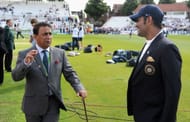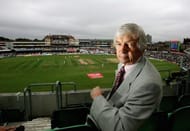Cricket is not only watched but is heard too. The 'thud' sound produced when Sachin Tendulkar kisses the ball with his willow, accompanied by the magical words from Harsha Bhogle, makes you fall in love with the game again and again. You just sit back and decide on what to admire first - the shot, the sound it produced or its summarization.
The commentary is one of the most quintessential parts of our game. So let’s decode some of the most important aspects of it.
#1 Precise and apt use of words
The commentary is not always about the usage of exaggerated words or display of shining vocabulary, rather it is an art of stitching together simple words in an exciting manner.
What distinguishes a certain Richie Benaud or Harsha Bhogle from the rest of the crop is their ability to say the right words at the right moment in such a flawless manner that you are left with no choice but to appreciate the genius of these storytellers who are a blessing to our game.
For instance, remember Harsha Bhogle calling that Kumble ton “The most romantic moment in Indian cricket history”? It’s all about following the basics and describing the game in a simple yet glorified manner.
#2 Let the moment sink in

Sunil Gavaskar fondly shares an incident of the time when he was sitting in the com box with Richie Benaud. “Some of my best lessons behind the microphone were taught to me by Richie Benaud.
"In a match when a batsman completed a century, I was about to pick my microphone but Richie stopped me and said, 'Let the viewers sink at the moment, let them applaud the batsman in their own way'. This was one of best lessons I learned in the com box”, says Gavaskar.
The commentary is not always about being loud and animated; sometimes it’s about acknowledging the significance of silence and allowing the fans to live through that magical moment.
#3 Voice modulation and importance of flow

What you speak is as vital as how you speak it. Voice modulation has an immense influence on your words. Realizing the value of pauses, understanding the importance of pitch and giving stress to certain words always help in making a listener’s experience joyful.
The commentary is not only about throwing words and clichés in the ears of fans. It’s about narrating the match like a story and describing the moment like poetry. Having a good command over the language and an even better control over your voice helps ace this underrated job.
#4 Helping the viewer understand the game better

Amidst the beautiful words, magical descriptions and a poetic voice, the basic motive of a commentator is to make the viewer understand the game in a better way, explaining to the viewer the reason of a particular field change or the changes in the batting order of a team.
That’s where the role of ex-cricketers comes into play because they understand the game better than anyone else. The likes of Nasser Hussain and Michael Holding are among the finest examples for this discussion.
The awareness of what is happening in the game and the ability to explain it through words in a simple manner remains at the core of a commentary job.
“Commentary to requires fierce concentration on every ball. Before opening your mouth, put your mind into gear”, said Richie Benaud. This sentence sums up the art of commentary, the art which brings great flavour to our glorious game.
Brand-new app in a brand-new avatar! Download CricRocket for fast cricket scores, rocket flicks, super notifications and much more! 🚀☄️
